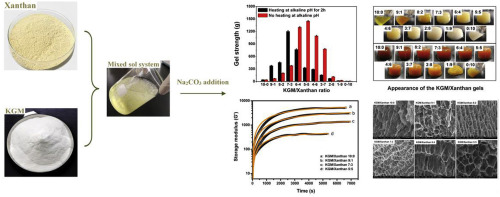当前位置:
X-MOL 学术
›
Food Hydrocoll.
›
论文详情
Our official English website, www.x-mol.net, welcomes your
feedback! (Note: you will need to create a separate account there.)
Improved physical properties of konjac glucomannan gels by co-incubating composite konjac glucomannan/xanthan systems under alkaline conditions
Food Hydrocolloids ( IF 11.0 ) Pub Date : 2020-09-01 , DOI: 10.1016/j.foodhyd.2020.105870 Xi Yang , Anqi Li , Dan Li , Xiaofei Li , Peiyuan Li , Lijun Sun , Yurong Guo
Food Hydrocolloids ( IF 11.0 ) Pub Date : 2020-09-01 , DOI: 10.1016/j.foodhyd.2020.105870 Xi Yang , Anqi Li , Dan Li , Xiaofei Li , Peiyuan Li , Lijun Sun , Yurong Guo

|
Abstract Alkali induced konjac glucomannan (KGM) gels have been a popular food item in many Asian nations since ancient times. However, there exist a few drawbacks for this type of gels, including significant syneresis and inferior gel strength, etc. In this study, due to relatively strong alkali resistance, xanthan was selected to be incorporated into KGM sol systems, and the composite KGM/xanthan systems were then allowed to gel by subjecting to a protocol consisting of incubating at 90 °C for 2 h and then cooling to room temperature. It was found that the gelation process consisted of two steps: during incubation at 90 °C, KGM gel network was predominantly formed, and the incorporation of xanthan caused a slower gelling rate of the KGM gel network. In the subsequent cooling process, xanthan synergistically bound with the KGM network, thereby strengthening the composite gels, with the binding process beginning at ~60 °C. When the KGM/xanthan ratio was 7:3, the highest gel strength (~1200 g) of the composite gel was obtained, which is much higher than the pure KGM gel (KGM/xanthan ratio 10:0, and the gel strength was ~44 g). Moreover, xanthan addition also decreased the syneresis rate of the composite gels during freeze-thaw treatment. Overall, the present study highlighted an applicable way to tailor the physical properties of KGM gels by co-incubating a composite KGM/xanthan system in the presence of alkali.
中文翻译:

通过在碱性条件下共培养复合魔芋葡甘露聚糖/黄原胶体系改善魔芋葡甘露聚糖凝胶的物理性质
摘要 碱诱导魔芋葡甘露聚糖(KGM)凝胶自古以来就是亚洲许多国家的流行食品。然而,这种类型的凝胶存在一些缺点,包括显着的脱水收缩和凝胶强度较差等。 本研究中,由于抗碱性较强,选择黄原胶加入到 KGM 溶胶体系中,复合 KGM/然后通过在 90 °C 下孵育 2 小时然后冷却至室温的方案使黄原胶系统凝胶化。发现凝胶过程包括两个步骤:在 90°C 孵育期间,主要形成 KGM 凝胶网络,而黄原胶的掺入导致 KGM 凝胶网络的凝胶化速度较慢。在随后的冷却过程中,黄原胶与 KGM 网络协同结合,从而加强复合凝胶,结合过程开始于~60°C。当KGM/黄原胶比为7:3时,复合凝胶的凝胶强度最高(~1200 g),远高于纯KGM凝胶(KGM/黄原胶比10:0,凝胶强度为约 44 克)。此外,黄原胶的添加还降低了复合凝胶在冻融处理过程中的脱水收缩率。总体而言,本研究强调了一种通过在碱存在下共同孵育复合 KGM/黄原胶系统来定制 KGM 凝胶物理特性的适用方法。并且凝胶强度为~44 g)。此外,黄原胶的添加还降低了复合凝胶在冻融处理过程中的脱水收缩率。总体而言,本研究强调了一种通过在碱存在下共同孵育复合 KGM/黄原胶系统来定制 KGM 凝胶物理特性的适用方法。并且凝胶强度为~44 g)。此外,黄原胶的添加还降低了复合凝胶在冻融处理过程中的脱水收缩率。总体而言,本研究强调了一种通过在碱存在下共同孵育复合 KGM/黄原胶系统来定制 KGM 凝胶物理特性的适用方法。
更新日期:2020-09-01
中文翻译:

通过在碱性条件下共培养复合魔芋葡甘露聚糖/黄原胶体系改善魔芋葡甘露聚糖凝胶的物理性质
摘要 碱诱导魔芋葡甘露聚糖(KGM)凝胶自古以来就是亚洲许多国家的流行食品。然而,这种类型的凝胶存在一些缺点,包括显着的脱水收缩和凝胶强度较差等。 本研究中,由于抗碱性较强,选择黄原胶加入到 KGM 溶胶体系中,复合 KGM/然后通过在 90 °C 下孵育 2 小时然后冷却至室温的方案使黄原胶系统凝胶化。发现凝胶过程包括两个步骤:在 90°C 孵育期间,主要形成 KGM 凝胶网络,而黄原胶的掺入导致 KGM 凝胶网络的凝胶化速度较慢。在随后的冷却过程中,黄原胶与 KGM 网络协同结合,从而加强复合凝胶,结合过程开始于~60°C。当KGM/黄原胶比为7:3时,复合凝胶的凝胶强度最高(~1200 g),远高于纯KGM凝胶(KGM/黄原胶比10:0,凝胶强度为约 44 克)。此外,黄原胶的添加还降低了复合凝胶在冻融处理过程中的脱水收缩率。总体而言,本研究强调了一种通过在碱存在下共同孵育复合 KGM/黄原胶系统来定制 KGM 凝胶物理特性的适用方法。并且凝胶强度为~44 g)。此外,黄原胶的添加还降低了复合凝胶在冻融处理过程中的脱水收缩率。总体而言,本研究强调了一种通过在碱存在下共同孵育复合 KGM/黄原胶系统来定制 KGM 凝胶物理特性的适用方法。并且凝胶强度为~44 g)。此外,黄原胶的添加还降低了复合凝胶在冻融处理过程中的脱水收缩率。总体而言,本研究强调了一种通过在碱存在下共同孵育复合 KGM/黄原胶系统来定制 KGM 凝胶物理特性的适用方法。











































 京公网安备 11010802027423号
京公网安备 11010802027423号